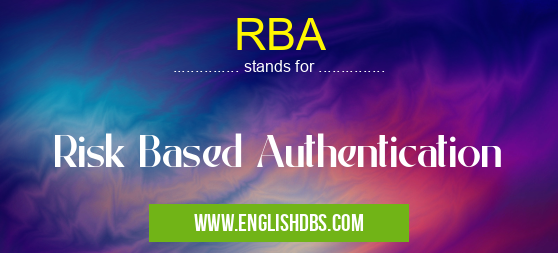What does RBA mean in UNCLASSIFIED
RBA (Risk Based Authentication) is a security measure that evaluates the risk of a transaction or user request based on various factors, such as the user's behaviour, device, and location. It helps organizations to prevent fraud and data breaches by implementing additional authentication steps when the risk is deemed high.

RBA meaning in Unclassified in Miscellaneous
RBA mostly used in an acronym Unclassified in Category Miscellaneous that means Risk Based Authentication
Shorthand: RBA,
Full Form: Risk Based Authentication
For more information of "Risk Based Authentication", see the section below.
RBA Explanation
RBA works by analyzing data from multiple sources to determine the risk associated with a particular action. This data may include:
- User behavior: Past login patterns, failed login attempts, and suspicious activities.
- Device information: Device type, operating system, IP address, and location.
- Transaction data: Amount of the transaction, type of transaction, and merchant involved.
Based on this analysis, RBA assigns a risk score to the transaction or request. If the risk score exceeds a predefined threshold, the system triggers additional authentication steps, such as:
- Multi-factor authentication (MFA): Requires the user to provide multiple forms of verification, such as a one-time password (OTP) or a biometric scan.
- Captcha or reCAPTCHA: Tests the user's ability to distinguish between humans and bots.
- Device binding: Links a user's account to a specific device or location.
Essential Questions and Answers on Risk Based Authentication in "MISCELLANEOUS»UNFILED"
What is Risk-Based Authentication (RBA)?
RBA is a security measure that analyzes user behavior and device characteristics to determine the risk associated with a login attempt. It evaluates factors such as IP address, location, device type, and previous login history to assess the likelihood of fraud or unauthorized access.
Why is RBA important?
RBA helps protect against data breaches, account takeovers, and other security threats by preventing unauthorized users from accessing sensitive information or performing malicious actions. It provides an additional layer of security beyond traditional authentication methods like passwords.
How does RBA work?
RBA uses machine learning algorithms and statistical models to evaluate risk. When a user logs in, their login attempt is compared against known patterns of behavior and device characteristics. If the system detects any anomalies or suspicious activities, it can trigger additional authentication steps or block access.
What are the benefits of using RBA?
RBA offers several benefits, including:
- Enhanced security and reduced risk of fraud
- Improved user experience by reducing the need for manual authentication
- Compliance with industry regulations and guidelines
- Cost savings by preventing data breaches and other costly incidents
What are some examples of RBA in practice?
RBA is used in various applications, such as:
- Online banking and financial transactions
- Accessing sensitive data or systems
- Remote login to corporate networks
- Social media and e-commerce platforms
Final Words: RBA is a valuable tool for organizations looking to enhance their security posture. By dynamically assessing risk and implementing appropriate authentication measures, RBA helps to prevent unauthorized access, protect sensitive data, and reduce the likelihood of fraud.
RBA also stands for: |
|
| All stands for RBA |
